 Duke Spring Football practice has moved inside due to weather but it continues as the Blue Devils ride the momentum of a ten win bowl season. BDN caught up to Anthony Boone to get the Duke quarterbacks thoughts - -
Duke Spring Football practice has moved inside due to weather but it continues as the Blue Devils ride the momentum of a ten win bowl season. BDN caught up to Anthony Boone to get the Duke quarterbacks thoughts - -



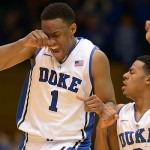 It took awhile for it to happen but there are few that haven't heard that tonight's Duke vs UNC game has been canceled due to inclement weather.
It took awhile for it to happen but there are few that haven't heard that tonight's Duke vs UNC game has been canceled due to inclement weather.
The make up date will be on February 20th but the ACC has yet to release a time for the game but that should happen in short order.
This means that Duke will now have just two days rest for their rematch with conference leader Syracuse. Not only that, Duke will now face the tremendous challenge of playing four games in eight days starting with the Maryland game this Saturday in Cameron Indoor Stadium.
Several logistical issues have yet to be addressed but many Duke fans rushed to ticket brokers to purchase tickets put up for sale in droves today when the snow started in earnest around noon. It remains to be seen how all that will go down.
From my perspective, cancelling the game was the right thing to do with concern to safety. It would also have been a bit unfair for Duke to have to travel in the conditions and play in a Dean Dome full of rowdy students making for a possibly uncontrolled or unusual environment and let's face it, no Duke versus UNC game should be played in said conditions.
While we as fans want to see this game go on, well, it just made sense to reschedule in light of safety issues. And for those thinking this helped Duke, I again point to four games in eight days.
 There is a winter storm warning brewing the Triangle area and that normally shuts down anything that moves but not the Duke versus UNC game. North Carolina Governor McCrory has already canceled his appearance and for good reason, but it appears the game will go on and much of the fan base is simply worried about possible power outages which would certainly make the Voice of the Blue Devils, Bob Harris smile.
There is a winter storm warning brewing the Triangle area and that normally shuts down anything that moves but not the Duke versus UNC game. North Carolina Governor McCrory has already canceled his appearance and for good reason, but it appears the game will go on and much of the fan base is simply worried about possible power outages which would certainly make the Voice of the Blue Devils, Bob Harris smile.
Governor McCrory said, "Don't put on your stupid hat," with the storm looming but isn't Duke vs UNC all about the craziness? That said, I still plan on trying to make it to and from the Dean Dome with stupid hat in tow. And maybe I will pick up a bag of marshmellows just in case we are forced to camp out in the media room and the overflow hall area that houses us for this particular game.
Believe it or not, there were rumors in Greensboro in the ACC offices that this game could be moved, but for some reason I think it goes on as planned. I mean, imagine those who've made special arrangements, including ESPN and one has to feel the show will go on.
This is not my first Duke-UNC game. Far from it. In fact, I have lost count of all that I have witnessed in person and on occasion from afar. But the one thing that is a given is that no other game gets fans going more than this storied college basketball rivalry.
You've heard it said before that one can throw out the results coming into this game and to a point that is true. While there have been occasions when one team was sure to win of sheer talent, there have been plenty of classic upsets, too numerous to speak of.
That said, what can we expect tomorrow? Well, that is simple. You can expect each team to play their style of ball in an effort to win.
The Tar Heels will run their back door cuts as they have for decades while Duke will shoot their share of three-point shots. The question is which team can implement their will on the other and that is where the picture muddles a bit.
With the exception of Syracuse, Duke and UNC are playing good basketball and this is what the fan base desires coming in. A win for UNC, provided they can follow-up which few do after wins over Duke would vault them back into the nation's top 25 teams.
Oddly, UNC has shown they can rise to the occasion against anyone with stellar out of conference wins which will almost certainly get them into the Big Dance, regardless of this games outcome.
Duke has played much better since and during their win over Virginia with their only loss coming on a controversial no call against Syracuse which could have effected the outcome.
In that game, Duke showed their ability to have different players step up and it's important in a rivalry game for that to happen again. Time and time again, it is a player, usually an upper classmen for the Blue Devils or the Heels who can play a heavy hand in the outcome.
Maybe this is a game where Leslie McDonald goes off or could it be an unexpected lift from another senior like Josh Hairtson?
It's no secret that the Tar Heels will try to pound the ball inside against Duke just as it is no secret Duke will try to cut the head off the UNC offense in defending Marcus Paige.
Those two things are but a few given things, but the game will ultimately come down to which team plays the best beyond their stars.
Can Jabari Parker allow the game to slow a bit and play consistently under control? Will Quinn Cook continue to shake his shooting slump or what if the Blue Devils get in early foul trouble defending the paint?
Questions abound and that is why we watch and attend the games. But one thing for certain is that this game despite the lack of the normal fanfare due the Tar Heels being just outside the Top 25 will be huge for both teams.
That means it comes down to effort and mental toughness. A year ago, Duke could depend on Plumlee and Kelly down low and both played well against the Tar Heels. But this season, well, it's a different team and one that faces the Heels for the first time as a unit.
In games like this, you have to weather storms of momentum and keep your focus. You play from timeout to timeout trying to win each or stay in the game until crunch time rolls around.
While we could see an easy win for one team or the other, this game has the early feel of one that will be close. Duke is the favorite here but not by much, especially in Chapel Hill.
Duke, however, has been playing as consistent as they have all season and in their last outing righted a sub par first half effort with an all no nonsense like second against Boston College.
UNC has rolled of late and they have as much momentum as Roy Williams could have hoped from when they once stood with a single ACC win.
You may have noticed that I have not talked much of individual players and that's because this will be a team win for the victor.
UNC has more momentum than at any other time this season while Duke has been playing solid of late save some defensive lapses in partial games.
I really feel the key for Duke is to play their game with perhaps a bit more pressure than normal out front. Another vital aspect will be to keep their front court players out of foul trouble to prevent UNC from playing volley ball with their size.
Both teams have righted the ship in the past couple of weeks after some early season losses and the Blue Devils seem hungry, yet so do the Heels.
That will make for a great game and possibly another classic. But for now, we'll all just have to wait a few more hours to see and that's half the fun when these two college basketball giants come together.
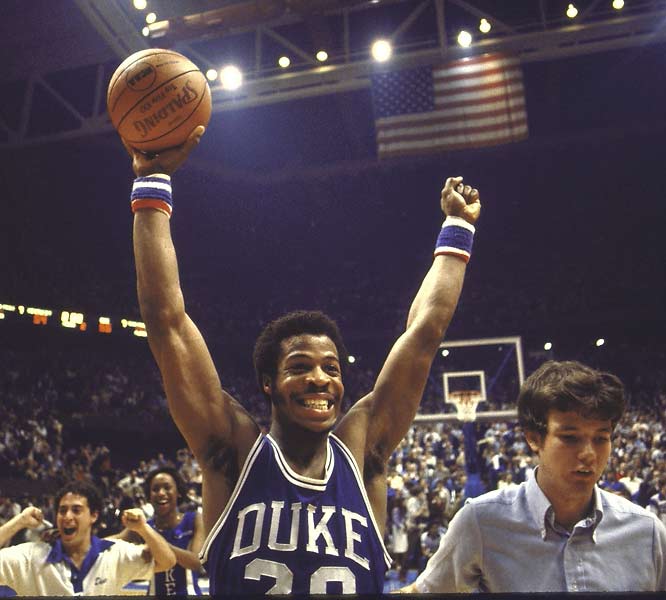
The date was February 28, 1981. First year coach Mike Krzyzewski led his unranked Duke team against a North Carolina team that would go on to play for the national championship. It was Coach K's first home game in The Rivalry, the last home game for senior captain Gene Banks and wildman Kenny Dennard. Before the game, Banks loped from the locker room dressed in a tuxedo and tossed roses into the crowd.
North Carolina, #11 in the AP poll, came into Cameron without the services of injured star forward James Worthy. Pumped by the energy of the fabled Cameron crowd, Duke came out strong and battled the more talented UNC team. 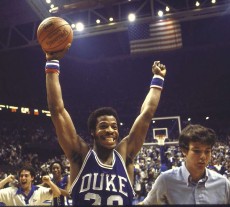 At halftime Carolina clung to a one point lead, and the second half was back and forth all the way through. A UNC bucket With two seconds to play put the Tar Heels ahead 58 to 56.
At halftime Carolina clung to a one point lead, and the second half was back and forth all the way through. A UNC bucket With two seconds to play put the Tar Heels ahead 58 to 56.
Duke inbounded from beneath its own basket. The Cameron scoreboard clock, which did not yet track tenths of seconds, ticked down to 0:01 left. Duke called a timeout and Dennard readied to inbound from midcourt. Coach K drew up the play. Junior Vince Taylor set a screen to spring sophomore Tom Emma, but Carolina slipped through it. Sharpshooter Chip Engelland, who despite taking most of his shots from the perimeter hit 55.7% of his attempts that season, set up in the corner, but too many Tar Heels intervened for Dennard to get the ball there safely. Banks saw the broken play and curled to the free throw line. Dennard floated the pass to Banks, who caught and spun. All American big man Sam Perkins hurried forward and extended his unnaturally long arms. Banks released. Perkins's fingers grazed the ball but didn't alter its trajectory and the shot descended through the hoop as the buzzer sounded, sending the crowd into a frenzy and the game into overtime. Four minutes and 41 seconds into the five minute overtime period, Banks rebounded a missed Taylor shot and laid it in for a 66-65 Duke win. Billy Packer was flabbergasted.
This was Duke/Carolina. The best rivalry in sports, where you throw out the record book and rankings don't matter. Anything can happen.
That's the narrative, anyway. But is it true? Can we really throw the rankings out the window when unranked North Carolina and #8 Duke square off this coming Wednesday?
Well, no, not really.
During Coach K's tenure in Durham, including the classic "Gene Banks game" his first season and twice last season, the historic rivals have met 25 times when one of them is ranked and the other unranked. The ranked team has won 21 of those 25 games, or 84.0% of the time. When Duke or UNC is ranked in the top ten and the other is unranked, the top team has won 18 of 21 (85.7%), and if one of the teams is in the top five and the other unranked, the top five team has won 14 of 15 (93.3%).
"So?" you might say, "at least the underdog won a few of them. That means something, right?"
Maybe. But comparing those results to Duke's games against two randomly selected ACC opponents, it doesn't look that way. During the Coach K years, Duke has faced Wake Forest 47 times when one is ranked and the other unranked. The ranked team won 40 of those games for a winning percentage of 85.1%. We've had 44 such games

against Clemson during that span and the ranked team has won 37 (84.1%). Pretty similar to the 84.0% in the Duke/UNC rivalry. Also in Duke/Clemson, one team has been in the top five while the other is unranked 28 times and the ranked team has won all 28. At least in Duke/UNC, the unranked team won once (UNC back in 1990, if you're curious). Well, if you want to hang your hat on one game, go ahead. But in the Duke/Wake series during Coach K's tenure, the top five team has only won 22 out of 29 of the games (75.9%). WAY less predictable than Duke/UNC. But the announcers don't tell us to throw out the record book when Wake comes to town, do they?
Believe it or not, Duke/UNC looks even less unpredictable if you expand it to include games when both teams have been ranked. In such games during Coach K's time, the higher ranked team has won 30 and lost 22, thus winning 57.7% of the time. In Duke/Wake it's been 9 to 9 (50%) and in Duke/Clemson 6 to 5 (54.5%), so the team you'd expect to win has done so more often in the Duke/UNC rivalry than in the others.
How about when one of the teams is in the top five and the other is outside the top ten? Duke and Carolina have played 18 such games during Coach K's time here, with the top five team winning 13, for a 72.2% success rate. Pretty unpredictable, wouldn't you say? Alas, that number's not much different than similar games against Wake, where the top five team has won 5 of 7 (71.4%) or against Clemson, where the top five team has won 4 of 5 (80%). So no luck there.
Just to be thorough, let's look at when both Duke and UNC are in the top ten. In that case, the higher ranked team has won 16 and lost 17 (48.5%), which seems to support the "anything can happen" meme until you consider that in such situations during the Duke/Wake series, the higher ranked top ten team has only won 3 and lost 6 (33.3%). This has only happened three times in Duke/Clemson since 1980-81, with the higher ranked team winning 2 and losing 1 (66.7%). When both teams are in the top five, the tally for Duke/UNC is 5 to 5, for Duke/Wake is 1 to 0, and for Clemson hasn't happened during the Coach K years.
Bottom line, in the Duke/UNC rivalry the team you expect to win usually does. About the same or even more so than in Duke's series with other ACC teams.
So is ESPN just making it up? Is The Rivalry not what we thought it was? I'm going to say "no" again. It's real and it's wonderful, as anybody who's had the good fortune to attend a Duke/UNC game can attest.
For one thing, unlike the Wake and Clemson series, whether the Duke/UNC underdog wins has little to do with venue. The upset winners in Duke/Wake and Duke/Clemson are almost always playing at home (79% of the unranked winners and 79% of the lower ranked winners when both are ranked). While it's true in the Duke/UNC rivalry that 3 of the 4 unranked winners (75%) played at home, that's a very small sample. When both teams are ranked, the lower ranked winners only played at home in 36% of the upsets (8 of 22).
But even putting that aside, the real magic of the Duke/UNC rivalry is not that "anything can happen." No, what makes it the stuff of legend is how amazingly good both teams are, year in and year out. Since Gene Banks put his mark on Duke history in 1981, Wednesday's game between Duke and Carolina will be the 76th meeting between the teams. And in those 76 games, either Duke or UNC has been ranked in the top ten in 73 of them (the only exceptions coming in the 2003 ACC Tournament, when #12 Duke beat unranked UNC, in 1997 when #12 Duke beat #19 UNC, and in 1996, when #19 UNC beat unranked Duke). Both Duke and UNC have been ranked in the top ten 33 times in Coach K's 33 seasons here (not counting this one since they haven't played yet). Ten times they've both been in the top five. One or the other (or both) of these teams have been ranked in 154 straight matchups (including this week's tilt), dating back to February 1955.
No other series can match that standard of excellence on both sides of the rivalry. In any sport. And because both teams are almost always so good, especially when you add in the close proximity of the schools and the genuine enmity the fanbases have for each other, the Duke/UNC rivalry truly is special. The players, the fans, and the coaching staffs bring a passion to the rivalry game unmatched in college sports.
So, relax, Duke/Carolina is still Duke/Carolina. And, likelihood aside, anything can happen. But while I wouldn't want to offend the weauxf gods, considering that this week Duke is in the top ten and UNC is unranked, you might also want to take at least a little bit of comfort in that 18 and 3 history, too.
Note: This article is an update of one originally published on this site on February 10, 2013
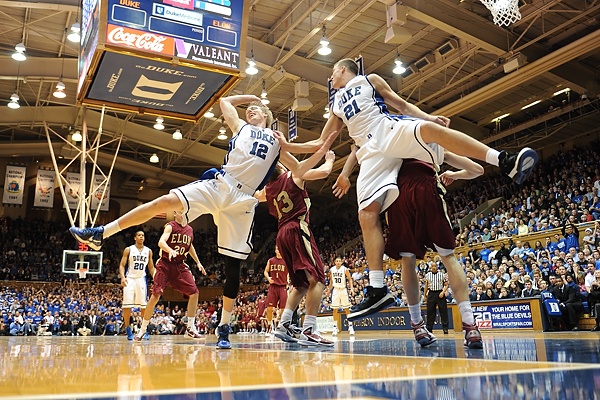
Every season, narratives develop in college basketball, and at least one of them involves Duke. These narratives evolve a life of their own, the media clings to them, the fans shout them at each other. And, accurate or not, the narratives grow until they're larger than life. 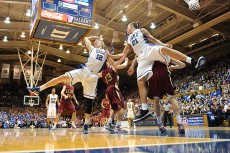 In 2009-10, Duke rode the "alarmingly unathletic" narrative all the way to a title. But still today, you hear people refer to that team as unathletic.
In 2009-10, Duke rode the "alarmingly unathletic" narrative all the way to a title. But still today, you hear people refer to that team as unathletic.
This season, the narrative is that size matters: Duke is too small; the team has no "true center" and therefore can't defend big players; Amile Jefferson is too skinny; Jabari Parker plays like a small forward; teams with big front courts will eat Duke alive on the boards.
It's gotten louder this week, as Duke visits Chapel Hill, where the Tar Heels' "huge frontcourt" threatens to "pound" Duke on the boards.
But is any of it true? Is Duke to small to rebound effectively? Let's take a look and find out.
First of all, all numbers in this article will be minute-independent, tempo-free stats rather than counting stats. Because if you only look at how many rebounds a team gathers, you're not looking at the whole picture. For example, if a team plays at a fast tempo, there are more possessions and therefore more rebounding opportunities than if a team plays at a slow tempo. Similarly, if a team shoots for a high percentage, there would necessarily be fewer offensive rebounding opportunities than if a team couldn't hit the broad side of the proverbial barn. For an individual player, it's obviously hard to get a large quantity of rebounds if he doesn't play a large quantity of minutes. So, instead of "rebounds per game," we'll refer here to "rebounding percentage," meaning what percentage of available rebounds a team or player collects.
Second, this article will not actually refer to rebounds in general but will always distinguish between offensive and defensive rebounds. Why? Well, for starters, the two require different skills. Defensive rebounding is mostly about positioning and boxing out and bulk. Offensive rebounding relies more on quickness and hustle and slashing to the ball. Second, and this may sound obvious, but defensive rebounding is part of a team's defense and offensive rebounding is part of a team's offense. If a team shoots really well, there aren't so many misses and offensive rebounding becomes less important. If a defense forces lots of turnovers, there are fewer opposing shots to rebound. And so on.
It's not entirely clear, but it would seem that the narrative we've been discussing concerns defensive rebounding. Even if it didn't, for a Duke team that has been rated top five in the country on offense for the entire season (currently ranked #1 by the Pomeroy ratings) but has been rated defensively between the 60s and the 140s (currently ranked #93 by Pomeroy), defensive rebounding is clearly more important for Duke this season. So let's start there.
Well, before we start let's ask one more question: does it matter? If Duke rebounds poorly will that doom the team to a disappointing season?
When looking at team defensive rebounding percentages, the percentages generally range from the low 60s to the low 70s. A percentage of 64% would usually rank a team in the worst 100 teams in the country at defensive rebounding, while a percentage of 70% will in most years rank you in the top 100. Historically, Duke under Coach K has not been a good defensive rebounding team. In fact, twelve times in Coach K's 33 seasons at Duke, the team has had a defensive rebounding percentage worse than 64%:
1997: 59.5% (293rd in the country)
1990: 60.3%
1996: 60.7%
1994: 61.4%
1993: 61.5%
2000: 62.0% (278th in the country)
2006: 62.3% (309th)
1992: 62.8%
2004: 62.9% (291st)
2005: 63.3% (287th)
1991: 63.7
2001: 63.9 (249th)
More than half of Coach K's Final Four teams are on that list, including three of Duke's four national champions. So to the question of whether strong defensive rebounding is necessary for a successful season, the answer is a resounding no.
On the other hand, let's look at Coach K's Duke teams with the five best defensive rebounding percentages:
2007: 69.6% (55th in the country)
1989: 68.8%
2012: 68.1% (168th)
2013: 67.6% (194th)
2010: 67.5% (174th)
We have two final four teams, including one national champion, on that list so clearly defensive rebounding doesn't hurt, but it's interesting to see that two of Duke's best three seasons in this category, 2007 and 2012, are two of the most disappointing Duke seasons in Coach K's tenure.
Still, most would agree that you'd rather rebound well than poorly. So, how has this year's small Duke team with no true center been rebounding on the defensive end?
How about the best defensive rebounding team in all Coach K's time at Duke? You heard right. So far, the 2013-14 Duke team has rebounded 70.2% of available defensive rebounds, better than the team's previous record of 69.6%.
Not only has defensive rebounding not been a weakness for Duke this season, it has been one of the team's strengths. So much for that narrative.
But maybe you've heard a new narrative, that since Coach K changed his substitution pattern in the Virginia game, the team has been rebounding so much better. Maybe that explains it?
Not really. While it's true Duke's offensive rebounding has improved since the Virginia game (more on that later), Duke's defensive rebounding percentage has actually gone down in that period. Although still not bad, as we've rebounded 67.7% of available defensive rebounds in those games.
But how's all that possible, with "rail-thin" Amile Jefferson and "small forward" Jabari Parker manning Duke's frontcourt?
Because they're both really good rebounders. Parker currently leads the ACC in rebounds per game and is 5th in the conference in defensive rebounding percentage, at 22.9%. Jefferson's defensive rebounding percentage is even better -- 23.9% -- good for 2nd in the conference, trailing only UNC's Kennedy Meeks.
Going back to 1997, here's a list of Duke's ten best individual seasons for defensive rebounding percentage:
DEFENSIVE REBOUNDING PERCENTAGE (minimum 15 mpg)
1T. 2010 Brian Zoubek, 24.4%
1T. 2012 Mason Plumlee, 24.4%
3. 2014 Amile Jefferson, 23.9%
4. 2006 Shelden Williams, 23.4%
5T. 2013 Mason Plumlee, 23.3%
5T. 2011 Mason Plumlee, 23.3%
7. 2014 Jabari Parker, 22.9%
8. 2012 Miles Plumlee, 22.7%
9T. 2005 Shelden Williams, 22.0%
9T. 2004 Shelden Williams, 22.0%
Carlos Boozer's best defensive rebounding percentage was 19.6%. Elton Brand's best was 20.5%. Both squarely in Jefferson's and Parker's rear-view.
Jefferson's and Parker's combined percentage of 46.8% is the 2nd best Duke duo since at least 1997 (and probably a lot further back), just a smidgen behind Mason and Miles Plumlee combining for 47.1% in 2012.
Just imagine how successful Duke's current front line would be if they were big enough...
For completeness' sake, here's a brief tour of Duke's offensive rebounding. Historically, Duke's offensive rebounding is better than its defensive rebounding. On this end of the floor, 30% is generally bottom 100 and a little higher than 34% is top 100. In Coach K's time at Duke, the team has only been under 34% twice: last season (2013), at 28.8% (273rd in the country), and in 2006, at 30.9% (275th). Because, despite those low percentages, both those teams had top five (in the nation) offenses, one could fairly argue that it didn't matter whether they excelled in offensive rebounding or not.
On the other hand, here are the top 10 Duke offensive rebounding seasons under Coach K:
1999: 44.3% (3rd in the country)
1990: 40.9%
2010: 40.6% (6th)
1988: 40.5%
1998: 39.7% (39th)
1992: 39.5%
2004: 39.2% (16th)
1996: 38.3%
1991: 38.0%
1994: 38.0%
Wow, right? Eight of the ten teams on this list made the Final Four (including three of our four national champions). Only one team on the list didn't at least make the Elite Eight. So, maybe offensive rebounding is important, after all.
With that in mind, how's this year's team doing in this category? Well, that's where the new substitution pattern comes in. For the season, Duke's offensive rebounding percentage is 34.1%, good for 106th in the country. But since the Virginia game, we've corralled 42.3% of available offensive rebounds, which for a whole season would put us up at 1999/2010 levels.
Leading the charge on this side of the boards is, again, skinny Amile Jefferson. He's collected 15.2% of available offensive rebounds, which ranks 4th in the ACC (one spot ahead of UNC's Meeks) and 29th in the country. This number would rank fourth at Duke since 1997 (among players playing 15+ mpg):
OFFENSIVE REBOUNDING PERCENTAGE (minimum 15 mpg)
1. 2010 Brian Zoubek, 21.6%
2. 2012 Miles Plumlee, 16.6%
3. 1998 Elton Brand, 16.4%
4. 2014 Amile Jefferson, 15.2%
5. 2003 Shelden Williams, 14.8%
6T. 2004 Shelden Williams, 14.7%
6T. 2003 Casey Sanders, 14.7%
8. 1999 Elton Brand, 14.3%
9. 2002 Carlos Boozer, 13.5%
10. 2011 Miles Plumlee, 13.3%
If you drop the minute requirement down to 7 mpg, the following enter into the table:
2007 Brian Zoubek, 16.9%
2009 Brian Zoubek, 16.7%
2008 Brian Zoubek, 16.1%
2005 Reggie Love, 15.9%
2000 Matt Christensen, 15.1%
2014 Marshall Plumlee, 14.9%
So the emergence of Marshall Plumlee in the rotation since the Virginia game may have something to do with Duke's improved performance in this statistic. (MP3 has yet to show a proficiency for defensive rebounding, however.)
But the season isn't over yet. Duke's run on the boards will face a big test this week against North Carolina. The Tar Heels collect 38.4% of available offensive rebounds (17th in the country) and 69.0% of available defensive rebounds. The game will feature the ACC's top two rebounders in Duke's Amile Jefferson (2nd in DR%; 4th in OR%) and UNC's Kennedy Meeks (1st in DR%; 5th in OR%), who also happens to outweigh Jefferson by 80 pounds.
Will Duke continue its historic (and some would say unlikely) success on the boards? Tune in Wednesday to find out.

You must be logged in to post a comment.